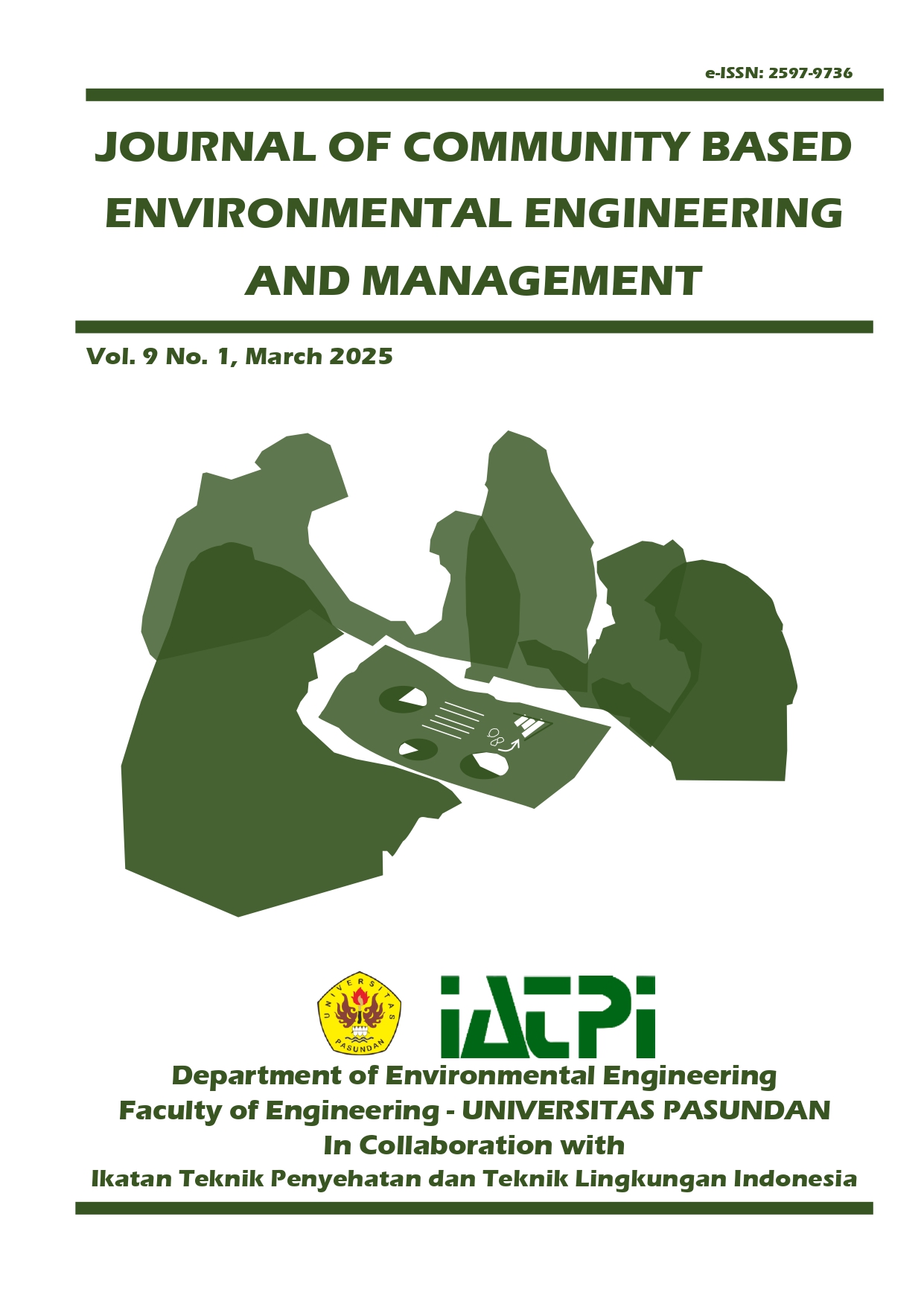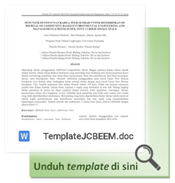Quantification Of Greenhouse Gas Emissions in a Cement Company and System Dynamics Modeling Toward Carbon Neutral
DOI:
https://doi.org/10.23969/jcbeem.v9i1.20395Keywords:
cement, emission mitigation, greenhouse gas emissions, emission quantification, system dynamicsAbstract
The cement industry is one of the sectors that produces carbon dioxide (CO2) emissions due to its raw material processing and energy requirements. CO2, as a greenhouse gas (GHG) emission, contributes to global warming, leading to environmental, health, and economic losses. To address these issues, Indonesia is committed to reducing GHG emissions in the industrial sector by 2050. To effectively plan for the reduction of GHG emissions generated by companies, this study aims to quantify emissions from a cement company, representing the cement industry in Indonesia, to understand the current state of the company's carbon footprint and identify feasible mitigation measures. The cement industry utilizes a GHG quantification system to calculate emissions from raw material processing, thermal energy consumption, and electricity purchases. The calculation results from a cement company are used for system dynamics modeling with Vensim PLE software for the period from 2021 to 2050, under business-as-usual (BAU) conditions with various emission reduction strategies. The results show that GHG emissions under BAU conditions with emission reduction strategies do not achieve carbon neutrality by 2050. More intensive adoption of decarbonization technologies, research on process optimization, and government policies such as carbon taxes and carbon trading are required to achieve carbon neutral goals.
Downloads
References
Antunes, M., Santos, R. L., Pereira, J., Rocha, P., Horta, R. B., & Colaço, R. (2021a). Alternative clinker technologies for reducing carbon emissions in cement industry: A critical review. Materials, 15(1), 209. https://doi.org/10.3390/ma15010209
Cantini, A., Leoni, L., De Carlo, F., Salvio, M., Martini, C., & Martini, F. (2021). Technological Energy Efficiency Improvements in cement industries. Sustainability, 13(7), 3810. https://doi.org/10.3390/su13073810
Cavalett, O., Watanabe, M.D.B., Voldsund, M. dkk. Paving the way for sustainable decarbonization of the European cement industry. Nat Sustain 7, 568–580 (2024). https://doi.org/10.1038/s41893-024-01320-y
Fankhauser, S., Smith, S. M., Allen, M., Axelsson, K., Hale, T., Hepburn, C., Kendall, J. M., Khosla, R., Lezaun, J., Mitchell-Larson, E., Obersteiner, M., Rajamani, L., Rickaby, R., Seddon, N., & Wetzer, T. (2021). The meaning of net zero and how to get it right. Nature Climate Change, 12(1), 15–21. https://doi.org/10.1038/s41558-021-01245-w
Global Cement and Concrete Association (GCCA). 2021. GCCA Concrete Future – Roadmap to Net Zero. United Kingdom: Global Cement and Concrete Association
Huang, M.-T., & Zhai, P.-M. (2021). Achieving paris agreement temperature goals requires carbon neutrality by middle century with far-reaching transitions in the whole society. Advances in Climate Change Research, 12(2), 281–286. https://doi.org/10.1016/j.accre.2021.03.004
Junianto, I., Sunardi, & Sumiarsa, D. (2023). The possibility of achieving zero CO2 emission in the Indonesian Cement Industry by 2050: A stakeholder system dynamic perspective. Sustainability, 15(7), 6085. https://doi.org/10.3390/su15076085
Jokar, Z., & Mokhtar, A. (2018). Policy making in the cement industry for CO2 mitigation on the pathway of sustainable development- a system dynamics approach. Journal of Cleaner Production, 201, 142–155. https://doi.org/10.1016/j.jclepro.2018.07.286
Khaiyum, M. Z., Sarker, S., & Kabir, G. (2023). Evaluation of carbon emission factors in the cement industry: An emerging economy context. Sustainability, 15(21), 15407. https://doi.org/10.3390/su152115407
Kementerian Lingkungan Hidup dan Kehutanan (KLHK). 2021. Indonesia Long-Term Strategy for Low Carbon and Climate Resilience 2050 (Indonesia LTS-LCCR 2050). Jakarta: Kementerian Lingkungan Hidup dan Kehutanan
Kementrian Perencanaan Pembangunan Nasional (Bappenas). 2021. Ringkasan Eksekutif Kebijakan Pembangunan Berketahanan Iklim (Climate Resilience Development Policy) 2020-2045. Jakarta: Kementrian Perencanaan Pembangunan Nasional (Bappenas)
Kunche, A., & Mielczarek, B. (2021). Application of system dynamic modelling for evaluation of Carbon Mitigation Strategies in cement industries: A comparative overview of the current state of the art. Energies, 14(5), 1464. https://doi.org/10.3390/en14051464
Lewis, C.D. (1982). International and Business Forecasting Methods. Butterworths, London.
Song, D., & Chen, B. (2014). A life cycle modeling framework for greenhouse gas emissions of cement industry. Energy Procedia, 61, 2649–2653. https://doi.org/10.1016/j.egypro.2014.12.267
Tang, M., Wang, S., Dai, C., & Liu, Y. (2020). Exploring CO2 mitigation pathway of local industries using a Regional-based system dynamics model. International Journal of Information Management, 52, 102079. https://doi.org/10.1016/j.ijinfomgt.2020.102079
The World Business Council for Sustainable Development (WBCSD). 2011. CO2 Accounting and Reporting Standard for the Cement Industry. www.wbcsd.org
Wen, L., Bai, L., Zhang, E., & Weng, J. (2016). A system dynamics model for industrial carbon emissions in Baoding. Mathematical and Computer Modelling of Dynamical Systems, 22(6), 555–568. https://doi.org/10.1080/13873954.2016.1206025
Pudasainee, D., Kurian, V., & Gupta, R. (2020). Coal. Future Energy, 21–48. https://doi.org/10.1016/b978-0-08-102886-5.00002-5
Pagoni, E. G., & Patroklos, G. (2019). A system dynamics model for the assessment of National Public–Private Partnership Programmes’ Sustainable Performance. Simulation Modelling Practice and Theory, 97, 101949. https://doi.org/10.1016/j.simpat.2019.101949
Supriya, Chaudhury, R., Sharma, U., Thapliyal, P. C., & Singh, L. P. (2023a). Low-CO2 emission strategies to achieve net zero target in cement sector. Journal of Cleaner Production, 417, 137466. https://doi.org/10.1016/j.jclepro.2023.137466
Yaffee, R.A. and McGee, M. (2000) Introduction to time series analysis and forecasting: With applications in SAS and SPSS. Academic Press,USA.
Zhang, X., Shen, J., Wang, Y., Qi, Y., Liao, W., Shui, W., Li, L., Qi, H., & Yu, X. (2017). An environmental sustainability assessment of China’s cement industry based on Emergy. Ecological Indicators, 72, 452–458. https://doi.org/10.1016/j.ecolind.2016.08.046
Zhou, W., Jiang, D., Chen, D., Griffy-Brown, C., Jin, Y., & Zhu, B. (2016). Capturing CO2 from cement plants: A priority for reducing CO2 emissions inChina. Energy, 106, 464–474, doi: 10.1016/j.energy.2016.03.090














